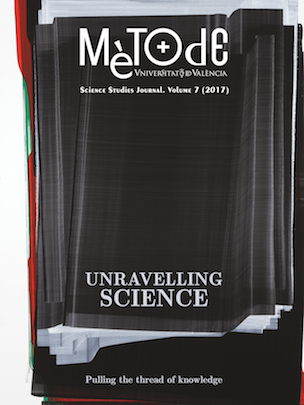Astronomy and space on the big screen: How accurately has cinema portrayed space travel and other astrophysical concepts?
DOI:
https://doi.org/10.7203/metode.7.8530Keywords:
astronomy, cinema and science fiction, space travel, asteroids, black holes Abstract
Abstract
Since its origins, cinema has been fascinated with the subject of scientific developments. In particular, astronomy and astrophysics have played an important role in science fiction stories about space travel and exploration. Though the science has not always been accurately represented, in the last decades there has been more and more interest from the cinema industry in approaching scientists to make sure that the stories and concepts shown in films are closer to our true understanding of the universe. In this article, I will explore how cinema has portrayed astrophysical concepts throughout the decades, and how sometimes cinema has even inspired the direction of scientific research.
 Downloads
Downloads
 References
References
Alcubierre, M. (1994). The warp drive: Hyperfast travel within general relativity. Classical Quantum Gravity, 11, L73–L77. doi: 10.1088/0264-9381/11/5/001
Alvarez, L. W., Alvarez W., Asaro, S., & Michel, H. V. (1980). Extraterrestrial cause for the Cretaceous-Tertiary extinction. Science, 208, 1095–1108. doi: 10.1126/science.208.4448.1095
Campbell, B., Walker, G. A. H., & Yang, S. (1988). A search for sub-stellar companions to Solar-type stars. Astronomical Journal, 331, 902–921. doi: 10.1086/166608
Einstein, A., & Rosen, N. (1935). The particle problem in the general theory of relativity. Physical Review, 48, 73–77. doi: 10.1103/PhysRev.48.73
Hawking, S. W. (1974). Black hole explosions. Nature, 248, 30–31. doi: 10.1038/248030a0
Kostov, V. B., Orosz, J. A., Welsh, W. F., Doyle, L. R., Fabrycky, D. C., Haghighipour, N., ... Borucki, W. J. (2016). Kepler-1647b: The largest and longest-period Kepler transiting circumbinary planet. The Astrophysical Journal, 827 (86). doi: 10.3847/0004-637X/827/1/86
Krauss, L. M. (1995). The physics of Star Trek. New York: Basic Books.
Lovell, J., & Kluger, J. (1994). Lost Moon: The perilous voyage of Apollo 13. Boston: Houghton Mifflin.
Moreno Lupiáñez, M., & José Pont, J. (1999). De King Kong a Einstein: La física en la ciencia ficción. Barcelona: Ediciones UPC.
Morris, M. S., & Thorne, K. S. (1988). Wormholes in spacetime and their use for interstellar travel: A tool for teaching general relativity. American Journal of Physics, 56 (5), 395–412. doi: 10.1119/1.15620
Perkowitz, S. (2007). Hollywood science: Movies, science and the end of the world. New York: Columbia University Press.
Sagan, C. (1985). Contact. New York: Simon and Schuster.
Thorne, K. S. (2014). The science of Interstellar. New York: W. W. Norton & Company.
Weir, A. (2014). The Martian. New York: Broadway Books.
Downloads
Published
How to Cite
-
Abstract2403
-
PDF920
Issue
Section
License
![]()
All the documents in the OJS platform are open access and property of their respective authors.
Authors publishing in the journal agree to the following terms:
- Authors keep the rights and guarantee Metode Science Studies Journal the right to be the first publication of the document, licensed under a Creative Commons Attribution-NonCommercial-NoDerivatives 4.0 International License that allows others to share the work with an acknowledgement of authorship and publication in the journal.
- Authors are allowed and encouraged to spread their work through electronic means using personal or institutional websites (institutional open archives, personal websites or professional and academic networks profiles) once the text has been published.





